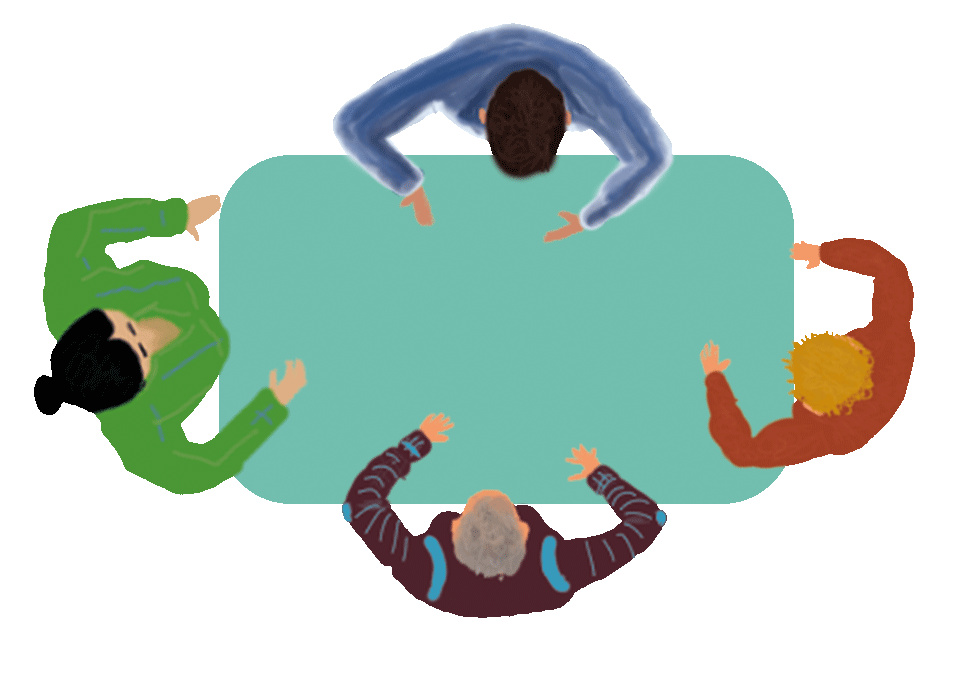
How can we have conversations
in which each person in turn
feels listened to and enriched
by the other people?
What is a Table of Four (ToF)?
The ToF is a way to explore in depth a question or dilemma with a few other people in order to discover new ways to deal with your issue.
You meet with a group of four people. Everyone has already considered in advance which issue they want to deal with. You toss a coin to decide who starts. Suppose Anna starts. She tells the other three her story behind her dilemma. At the moment only Anna is speaking and the other three are listening.
As soon as Anna indicates that she has finished her story, the other three persons take turns responding to her dilemma. For example, when Dirk starts to respond, the other three people keep listening. Nobody interrupts anyone else. When Dirk says that he has finished, it is the next person's turn to respond to Anna.
So at the end, three people have made suggestions and Anna can let their responses take effect on her and choose which suggestions, if any, to take with her or perhaps to act on. That's the handy thing about this process. Anna decides for herself what to do with these responses and often this decision process requires time beyond the ToF.
In other words, the "Table of Four" is a way:
- for you to feel listened to and seen by other people in the issue that is important to you, and your story behind it.
- for you to hear suggestions from the listeners on how you could refine your question, on how you could deal differently with your issue, or how you could look at your story differently.
That is why the following roles exist within the ToF:
- one person is central, determines the subject and is therefore the "speaker";
- the others have the role of "active listener" and are present with open, accepting attention.
After this, the next person is the "speaker". Then the next, etc. To ensure that each participant has the opportunity to discuss his or her issue, a ToF ideally consists of a maximum of four people. This is explained in 'How many people may participate in a single ToF'.
What is the difference between a "Table of Four" and a conversation in everyday life?
People often experience everyday conversations as an important and fun contribution to their lives. It also often gives a feeling of togetherness. Sometimes an everyday conversation can have similarities to a ToF, but there are often important differences which are explained below.
During a ToF, each participant is given the time and opportunity to present his or her topic.
In everyday conversations people often tune in to each other as to what they are talking about. Then the topic of conversation is about an (implicitly) agreed common denominator: the weather, friendships, family, work or the latest news.
It may also happen that someone uses a part of your story as a link to telling their own story. That can sometimes be about something completely different fromwhat is important to you.
The ToF process is primarily about "Active Listening": the speaker feels heard and understood by the others.
In an everyday conversation, it often happens that people spend time thinking about how they plan to respond to what is being said, rather than paying attention and listening. Others just wait for the chance to hear themselves speak.
A ToF increases the possibility of getting new ideas that you can use to make progress with your issue.
In an everyday conversation it can happen that people give you advice, albeit well-intentioned, too early and without being asked. You will notice from their advice if they have not understood you properly, so that this advice may not be helpful to you.
In a ToF it is about Both-And instead of Either-Or thinking
In an everyday conversation, one person can state an opinion very firmly, with the attitude "My idea is better than yours" or "You're wrong; I am right” (Either-Or thinking). Often, no one else will dare to argue with them. This silencing is strengthened if some members of the group go along with the person with strongly stated views, and others feel there is no point saying what they really think, or simply cannot be bothered. As a result, there is a good chance that important Both-And insights will be lost and the possibility of creative innovation will disappear.
Confidentiality
In an everyday conversation there is usually no mention of confidentiality
What could you achieve with a Table of Four (ToF)?
With friends:
- Support each other with everyone's (life) questions.
- Make common issues discussable.
- Promote equality: everyone gets the chance to share his or her issue.
- Increase mutual involvement and connection.
- Increase social safety.
- Breaking through corona isolation
via zoom, skype, small groups at home, if permitted.
For yourself:
- When you get stuck with a dilemma or issue in your head, it can be inspiring to hear someone else's perspective and suggestions. In this way your brain makes new connections and you have the chance that you will break out of “thinking in circles”.
- To experience what it is like to feel heard and seen with your story.
In organizations and education:
- Intervision
- Teams helping each other to support their issues.
- Supporting students who work individually or together on an assignment to inspire one another, especially when they are at risk of getting stuck or in need of inspiration.
- Learning to deal creatively with differences by promoting Both-And thinking and Active Listening.
Would you like to read more?
